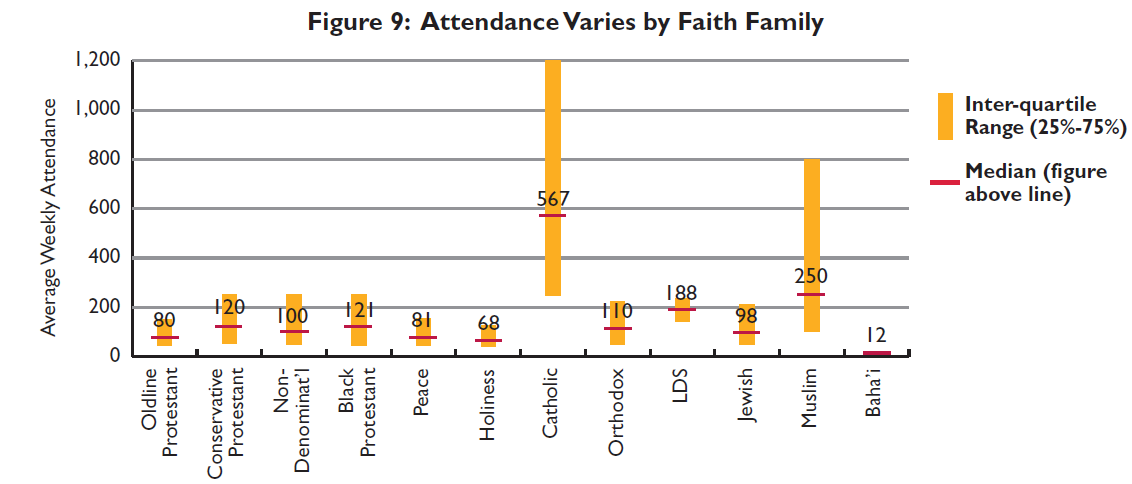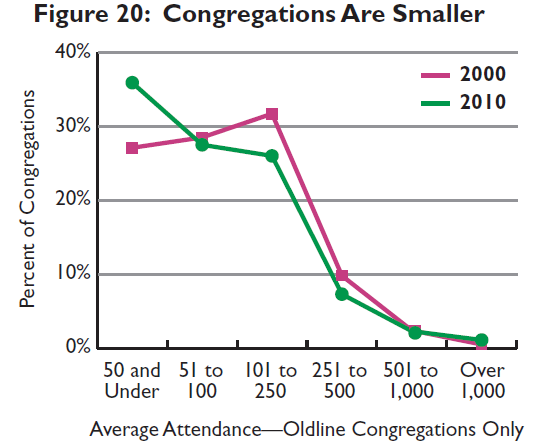 “FACTS on Worship: 2010,” the latest Faith Communities Today (FACT) report, provides insight into the current worship practices in churches by means of an aggregated data set that includes responses from over 11,000 congregations affiliated with over 120 denominations.
“FACTS on Worship: 2010,” the latest Faith Communities Today (FACT) report, provides insight into the current worship practices in churches by means of an aggregated data set that includes responses from over 11,000 congregations affiliated with over 120 denominations.
Worship is changing. The latest research shows increasing diversity in several areas, including:
- Time: Most services are held on Sunday morning (74%), but other weekend options are significant: Sunday evening (16%), Saturday (8%), and Friday (2%).
- Style: Contemporary worship continues to grow (e.g., for all Protestants: 43% in 2010 compared to 29% in 2000) as does the newer alternative style (driven primarily by the Emerging Church Movement). Additionally, most (53%) congregations experienced some change in worship during the most recent five year period.
- Language: About 10% of congregations use a language other than English, including liturgical languages, in worship at least on occasion.
Worship attendance varies by faith family as is illustrated with select groups below. Additionally, most worship gatherings are relatively small in size with roughly half (49%) featuring 100 or fewer participants. By size the distributions follow:
- 50 and under: 27%
- 51 to 100: 22%
- 101 to 250: 28%
- 251 to 500: 13%
- 501 to 1000: 6%
- over 1000: 4%
So What?
Decline in the mainline is a featured topic here at sowhatfaith. As a lifelong member of various traditions that fall within this group (known in the FACT report as oldline), I continually seek to better understand not only how fast it is contracting (membership numbers, worship attendance, giving, etc.), but also why. One graph within the report (figure 20) calls attention to just how fast these congregations are shrinking:
For a more in-depth snapshot of Oldline worship today, I excerpted comparative data from the appendix:
|
Denomination |
Median Average Attendance |
Innovative & Contemporary Worship |
High Spiritual Vitality |
|
Christian Church (Disciples of Christ) |
75 |
17% |
24% |
|
Episcopal Church |
104 |
5% |
28% |
|
Evangelical Lutheran Church in America |
100 |
11% |
15% |
|
Presbyterian Church (U.S.A.) |
70 |
9% |
26% |
|
United Church of Christ |
70 |
8% |
17% |
|
United Methodist Church |
60 |
14% |
20% |
The way forward is uncertain, but without significant change the only realistic path is that of continued decline. Oldline leaders should especially note the following:
- Decreasing average median worship attendance over the last decade is not unique to the Oldline. More specifically, “The median size of the congregation decreased in every Christian denominational group” (p. 11).
- Growth in average median worship attendance was positively correlated with services characterized as joyful, innovative and inspirational (notably congregations implementing change in worship experienced significantly higher rates of conflict); offering multiple worship services; and the use of drums, electric guitars and projection equipment.
- Innovation in worship is more common in the West and South than in the Northeast as well as more likely in urban areas, downtown and both older and newer suburbs than in rural areas. Congregations dominated by older members are less likely to innovate and more likely to use organ music in worship.
What are the implications of FACTS on Worship: 2010 for your local congregation?
- Compare your congregation’s average worship attendance in 2000 to the most recent statistics available (likely those for 2011). What is the percent change during that time frame? What changes in worship were implemented? How did worship changes (or worship stability) impact worship attendance?
- Of the following descriptive words, which best describe (choose as many as fit well) your congregation’s current worship service experiences: joyful, innovative, inspirational, reverent, thought provoking, filled with God’s Presence?
- Does your congregation offer worship services that resonate with both its current membership and the target demographic(s) for future growth? What guidelines does your congregational leadership use to measure stylistic relevance?

